BTEC HND Business: Analyzing Management and Leadership Styles
VerifiedAdded on 2021/11/24
|19
|3444
|488
Report
AI Summary
This report provides a detailed analysis of management and leadership styles, contrasting their characteristics and approaches. It examines various management styles, including democratic, authoritarian, and laissez-faire, using examples like Apple, Microsoft, and Google to illustrate their practical application. Furthermore, the report delves into leadership styles, focusing on transactional and transformational leadership, with examples such as Bill Gates and Jeff Bezos. The document highlights the differences between management and leadership, emphasizing that management focuses on short-term goals, stability, and control, while leadership emphasizes long-term vision and inspiration. It further explores the characteristics of managers, highlighting the importance of practical knowledge, continuous practice, and creativity, while also recognizing management as a science. This comprehensive analysis provides valuable insights into the distinct yet interconnected roles of management and leadership in organizational success. Desklib offers a wide range of solved assignments and past papers for students seeking academic support.

ASSIGNMENT … FRONT SHEET
Qualification BTEC Level 4 HND Diploma in Business
Unit number and title Unit 4: Management and Operations (488)
Submission date Date received (1 st submission)
Re-submission date Date received (2 nd submission)
Group number:
Student names & codes Final scores Signatures
1.
2.
3.
4.
5.
Class Assessor name
Student declaration
By signing on this front sheet, I certify that my contribution in this assignment submission is entirely my own work and I fully understand the
consequences of plagiarism. I understand that making a false declaration is a form of malpractice.
P1 P2 P3 M1 M2 D1
Qualification BTEC Level 4 HND Diploma in Business
Unit number and title Unit 4: Management and Operations (488)
Submission date Date received (1 st submission)
Re-submission date Date received (2 nd submission)
Group number:
Student names & codes Final scores Signatures
1.
2.
3.
4.
5.
Class Assessor name
Student declaration
By signing on this front sheet, I certify that my contribution in this assignment submission is entirely my own work and I fully understand the
consequences of plagiarism. I understand that making a false declaration is a form of malpractice.
P1 P2 P3 M1 M2 D1
Paraphrase This Document
Need a fresh take? Get an instant paraphrase of this document with our AI Paraphraser
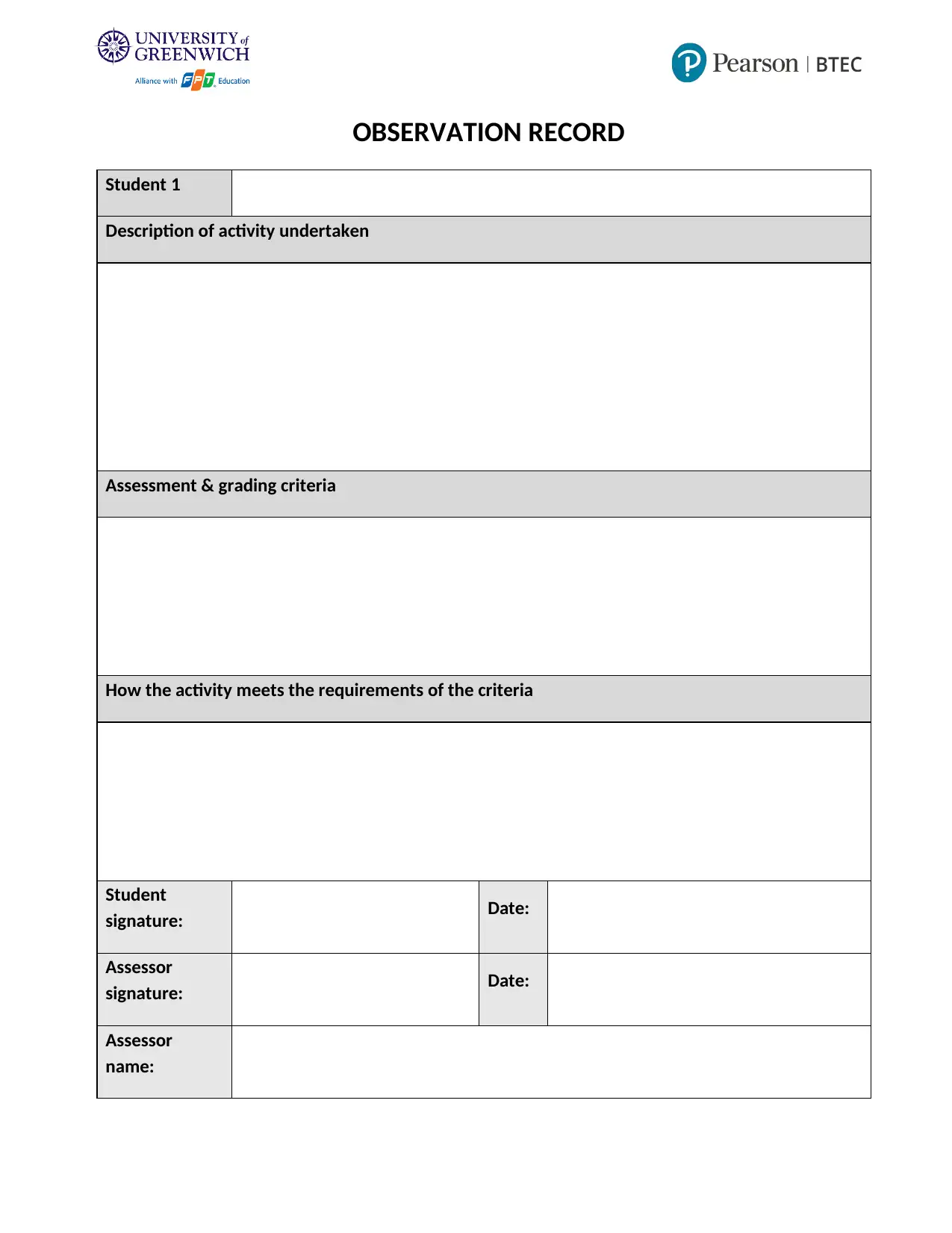
OBSERVATION RECORD
Student 1
Description of activity undertaken
Assessment & grading criteria
How the activity meets the requirements of the criteria
Student
signature: Date:
Assessor
signature: Date:
Assessor
name:
Student 1
Description of activity undertaken
Assessment & grading criteria
How the activity meets the requirements of the criteria
Student
signature: Date:
Assessor
signature: Date:
Assessor
name:
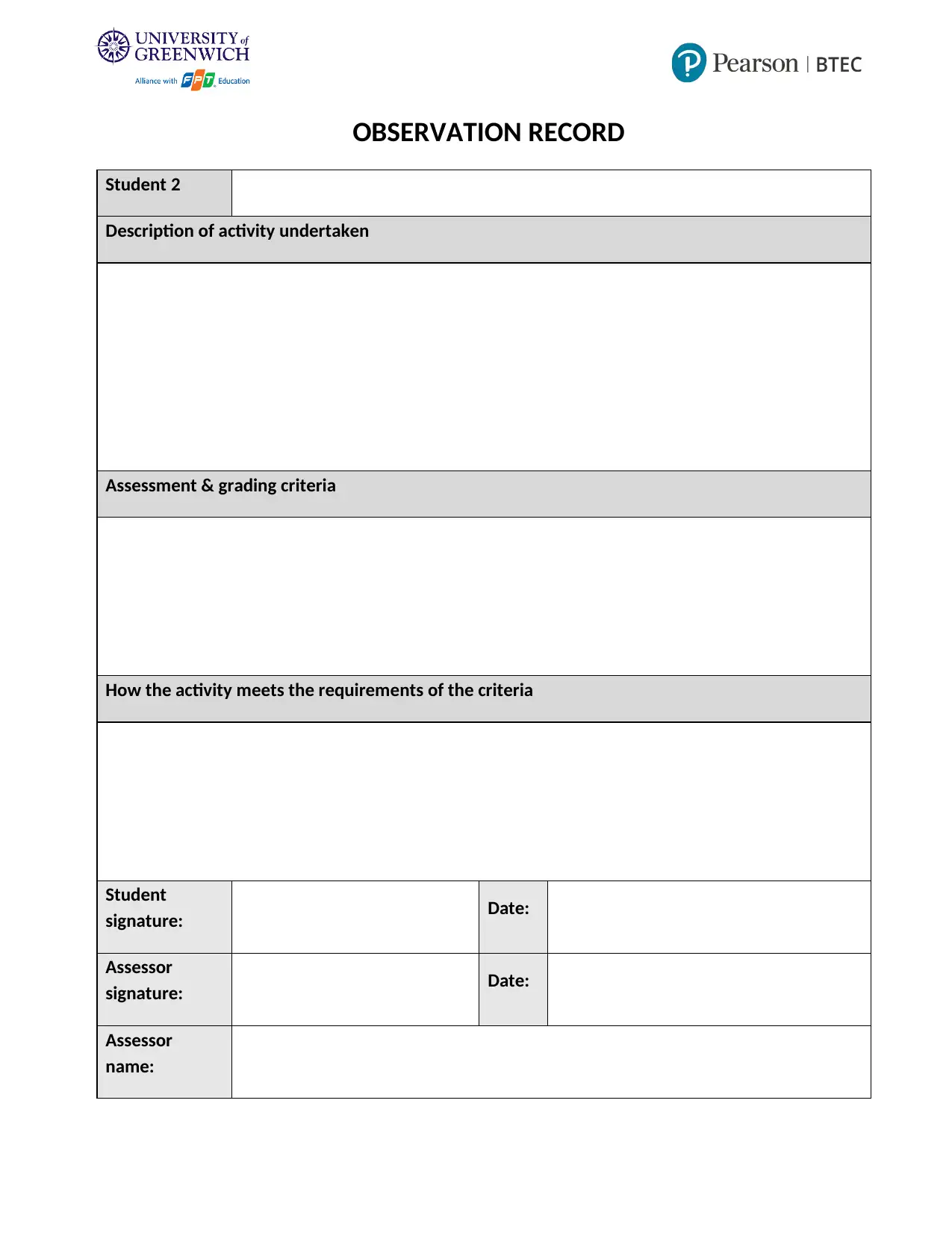
OBSERVATION RECORD
Student 2
Description of activity undertaken
Assessment & grading criteria
How the activity meets the requirements of the criteria
Student
signature: Date:
Assessor
signature: Date:
Assessor
name:
Student 2
Description of activity undertaken
Assessment & grading criteria
How the activity meets the requirements of the criteria
Student
signature: Date:
Assessor
signature: Date:
Assessor
name:
⊘ This is a preview!⊘
Do you want full access?
Subscribe today to unlock all pages.

Trusted by 1+ million students worldwide
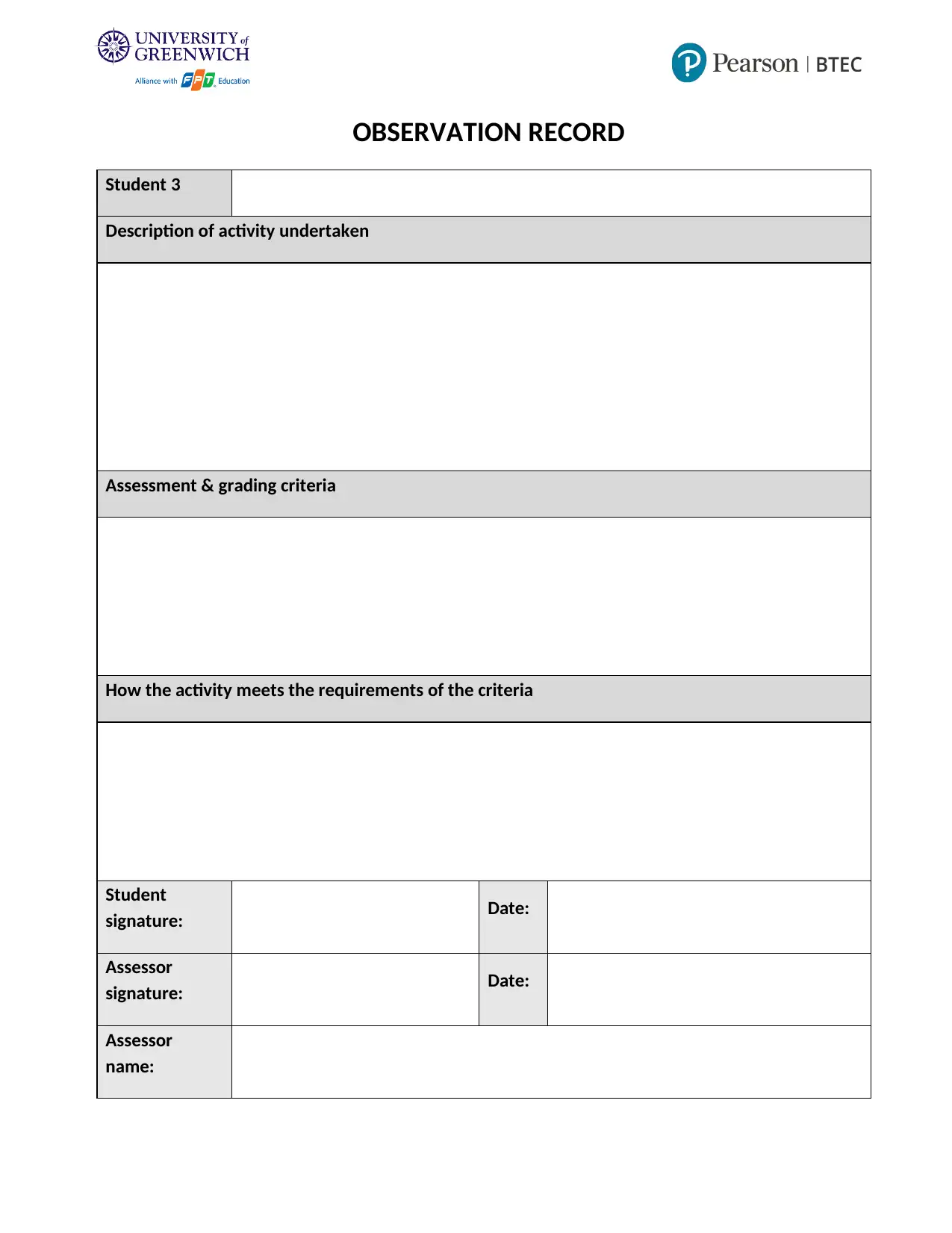
OBSERVATION RECORD
Student 3
Description of activity undertaken
Assessment & grading criteria
How the activity meets the requirements of the criteria
Student
signature: Date:
Assessor
signature: Date:
Assessor
name:
Student 3
Description of activity undertaken
Assessment & grading criteria
How the activity meets the requirements of the criteria
Student
signature: Date:
Assessor
signature: Date:
Assessor
name:
Paraphrase This Document
Need a fresh take? Get an instant paraphrase of this document with our AI Paraphraser
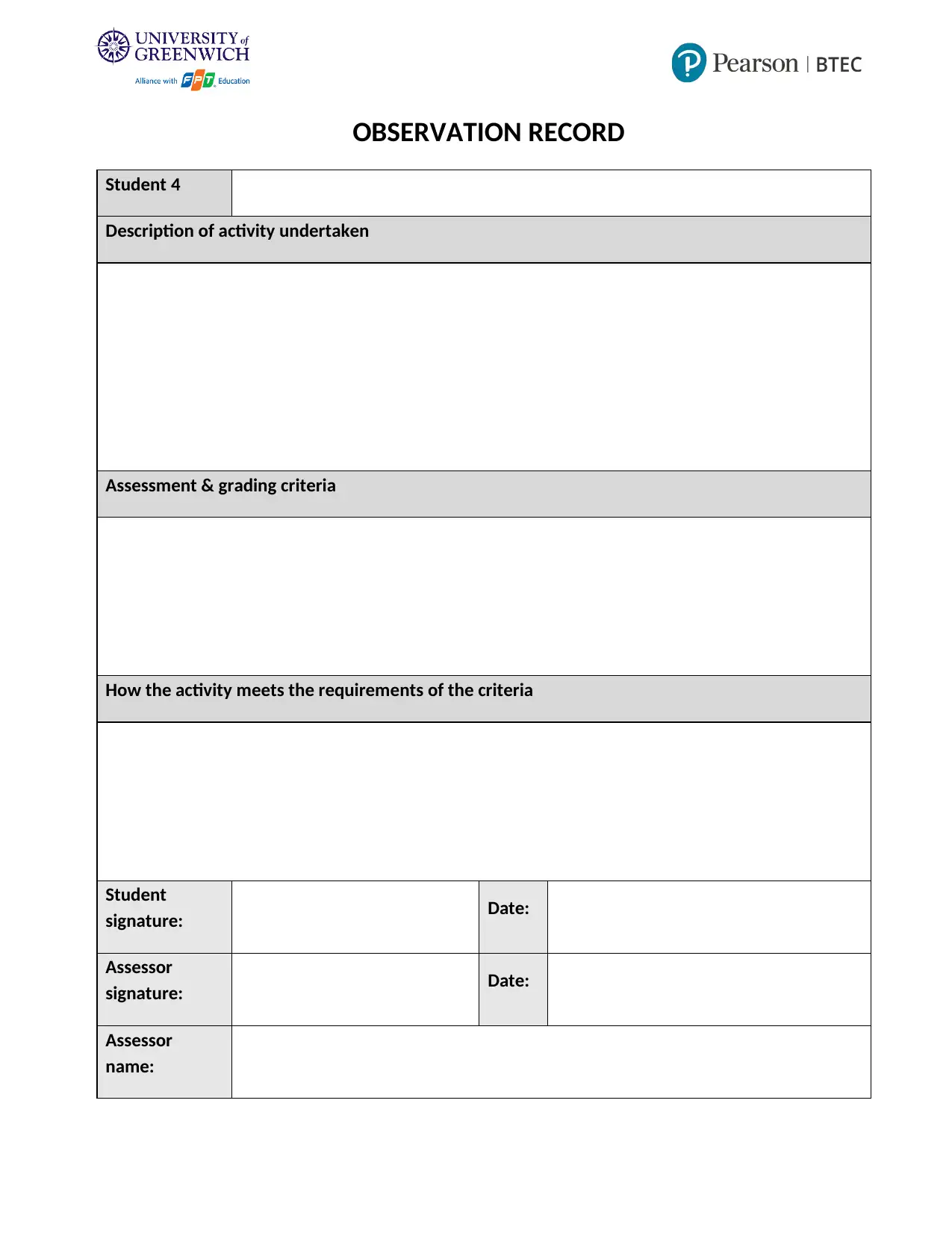
OBSERVATION RECORD
Student 4
Description of activity undertaken
Assessment & grading criteria
How the activity meets the requirements of the criteria
Student
signature: Date:
Assessor
signature: Date:
Assessor
name:
Student 4
Description of activity undertaken
Assessment & grading criteria
How the activity meets the requirements of the criteria
Student
signature: Date:
Assessor
signature: Date:
Assessor
name:
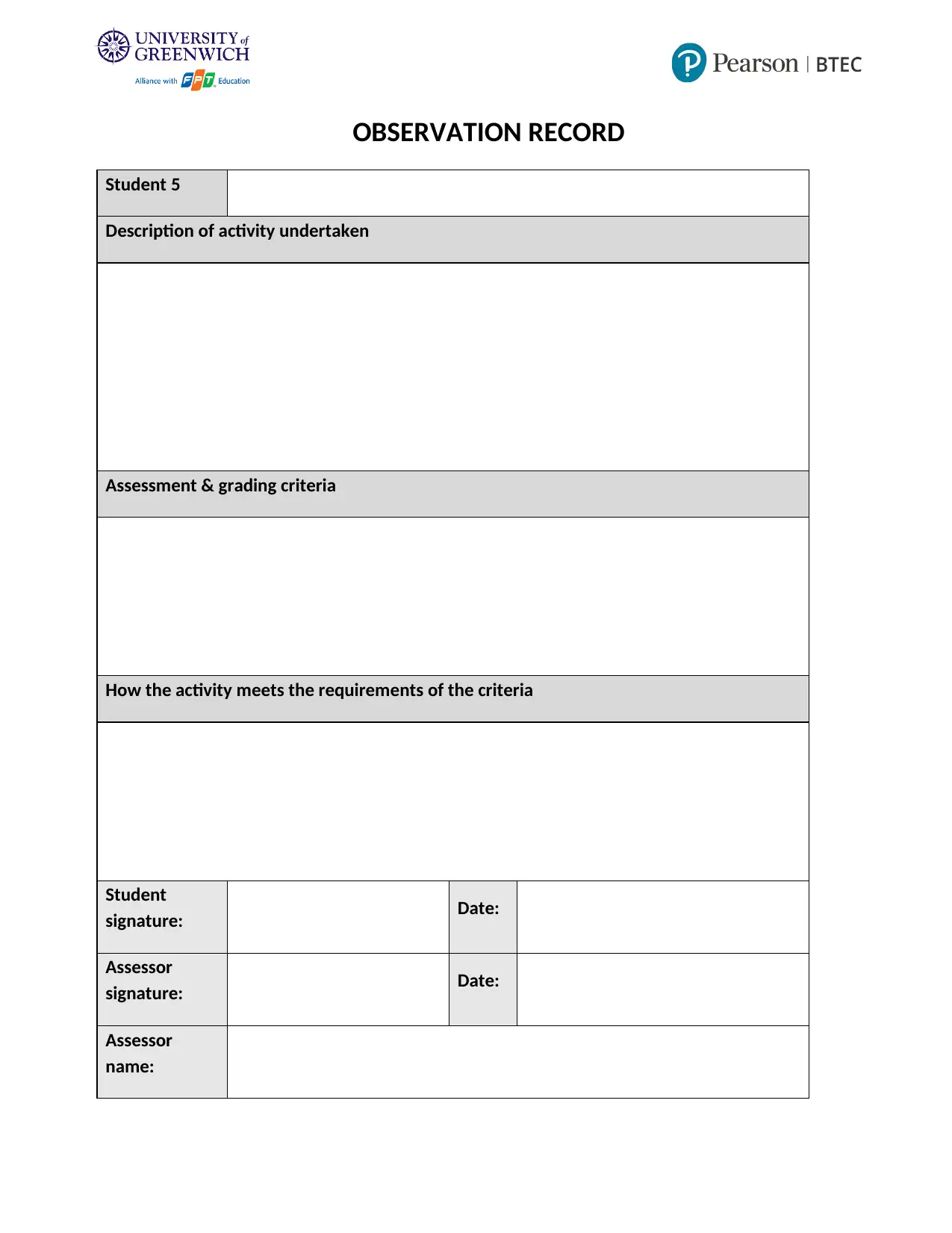
OBSERVATION RECORD
Student 5
Description of activity undertaken
Assessment & grading criteria
How the activity meets the requirements of the criteria
Student
signature: Date:
Assessor
signature: Date:
Assessor
name:
Student 5
Description of activity undertaken
Assessment & grading criteria
How the activity meets the requirements of the criteria
Student
signature: Date:
Assessor
signature: Date:
Assessor
name:
⊘ This is a preview!⊘
Do you want full access?
Subscribe today to unlock all pages.

Trusted by 1+ million students worldwide

Summative Feedback: Resubmission Feedback:
Grade: Assessor Signature: Date:
Internal Verifier’s Comments:
Signature & Date:
* Please note that grade decisions are provisional. They are only confirmed once internal and external moderation has taken
place and grades decisions have been agreed at the assessment board.
Grade: Assessor Signature: Date:
Internal Verifier’s Comments:
Signature & Date:
* Please note that grade decisions are provisional. They are only confirmed once internal and external moderation has taken
place and grades decisions have been agreed at the assessment board.
Paraphrase This Document
Need a fresh take? Get an instant paraphrase of this document with our AI Paraphraser
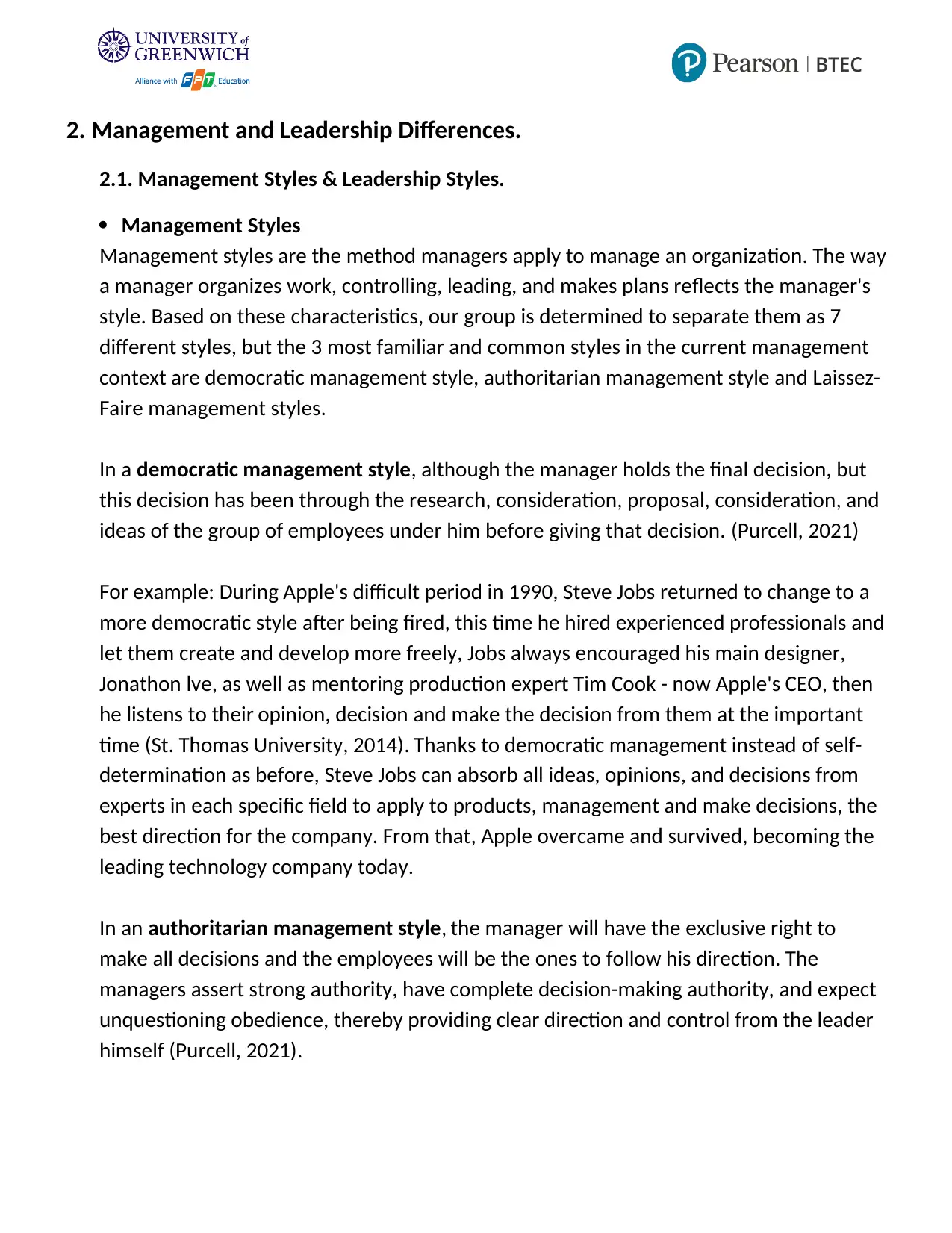
2. Management and Leadership Differences.
2.1. Management Styles & Leadership Styles.
Management Styles
Management styles are the method managers apply to manage an organization. The way
a manager organizes work, controlling, leading, and makes plans reflects the manager's
style. Based on these characteristics, our group is determined to separate them as 7
different styles, but the 3 most familiar and common styles in the current management
context are democratic management style, authoritarian management style and Laissez-
Faire management styles.
In a democratic management style, although the manager holds the final decision, but
this decision has been through the research, consideration, proposal, consideration, and
ideas of the group of employees under him before giving that decision. (Purcell, 2021)
For example: During Apple's difficult period in 1990, Steve Jobs returned to change to a
more democratic style after being fired, this time he hired experienced professionals and
let them create and develop more freely, Jobs always encouraged his main designer,
Jonathon lve, as well as mentoring production expert Tim Cook - now Apple's CEO, then
he listens to their opinion, decision and make the decision from them at the important
time (St. Thomas University, 2014). Thanks to democratic management instead of self-
determination as before, Steve Jobs can absorb all ideas, opinions, and decisions from
experts in each specific field to apply to products, management and make decisions, the
best direction for the company. From that, Apple overcame and survived, becoming the
leading technology company today.
In an authoritarian management style, the manager will have the exclusive right to
make all decisions and the employees will be the ones to follow his direction. The
managers assert strong authority, have complete decision-making authority, and expect
unquestioning obedience, thereby providing clear direction and control from the leader
himself (Purcell, 2021).
2.1. Management Styles & Leadership Styles.
Management Styles
Management styles are the method managers apply to manage an organization. The way
a manager organizes work, controlling, leading, and makes plans reflects the manager's
style. Based on these characteristics, our group is determined to separate them as 7
different styles, but the 3 most familiar and common styles in the current management
context are democratic management style, authoritarian management style and Laissez-
Faire management styles.
In a democratic management style, although the manager holds the final decision, but
this decision has been through the research, consideration, proposal, consideration, and
ideas of the group of employees under him before giving that decision. (Purcell, 2021)
For example: During Apple's difficult period in 1990, Steve Jobs returned to change to a
more democratic style after being fired, this time he hired experienced professionals and
let them create and develop more freely, Jobs always encouraged his main designer,
Jonathon lve, as well as mentoring production expert Tim Cook - now Apple's CEO, then
he listens to their opinion, decision and make the decision from them at the important
time (St. Thomas University, 2014). Thanks to democratic management instead of self-
determination as before, Steve Jobs can absorb all ideas, opinions, and decisions from
experts in each specific field to apply to products, management and make decisions, the
best direction for the company. From that, Apple overcame and survived, becoming the
leading technology company today.
In an authoritarian management style, the manager will have the exclusive right to
make all decisions and the employees will be the ones to follow his direction. The
managers assert strong authority, have complete decision-making authority, and expect
unquestioning obedience, thereby providing clear direction and control from the leader
himself (Purcell, 2021).
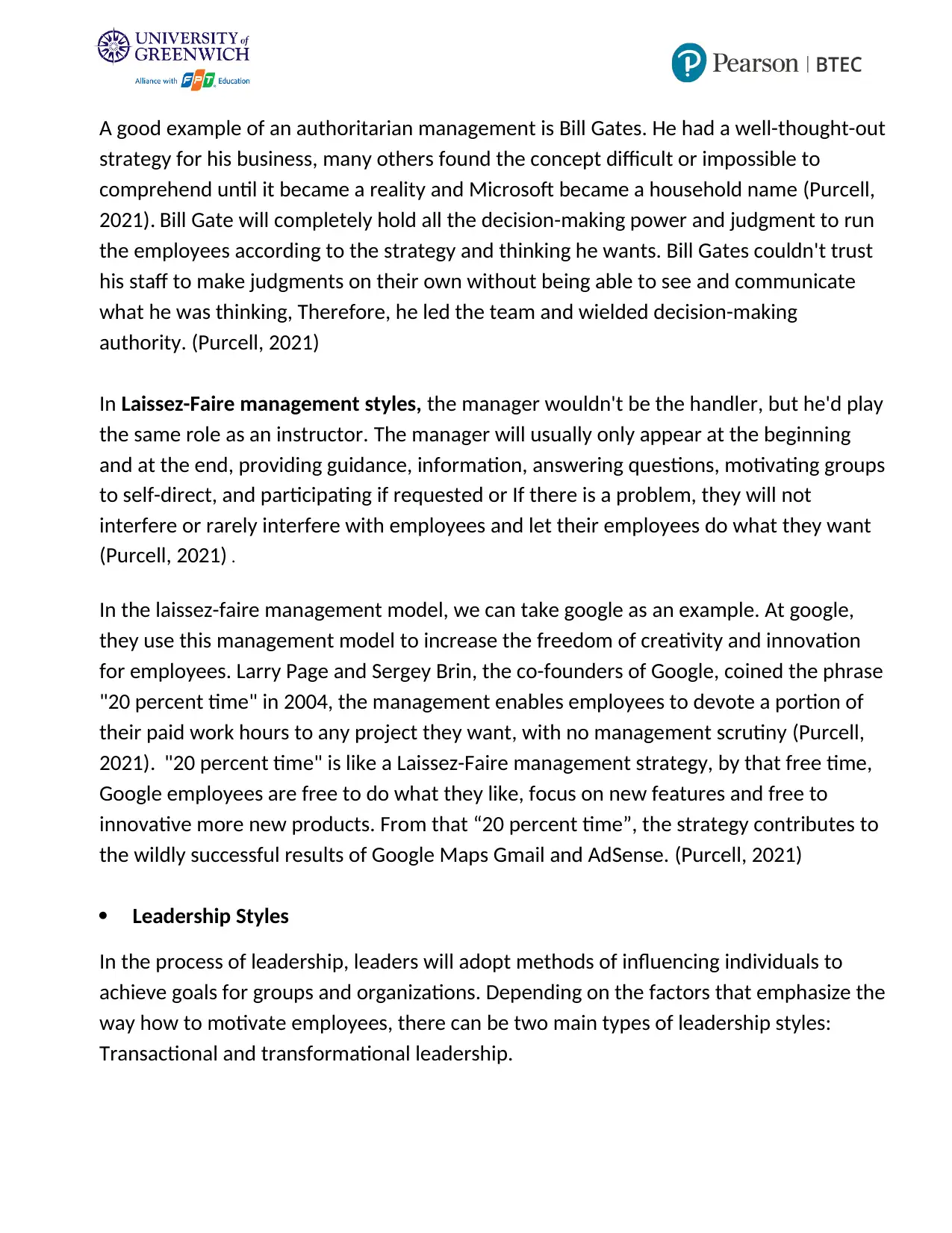
A good example of an authoritarian management is Bill Gates. He had a well-thought-out
strategy for his business, many others found the concept difficult or impossible to
comprehend until it became a reality and Microsoft became a household name (Purcell,
2021). Bill Gate will completely hold all the decision-making power and judgment to run
the employees according to the strategy and thinking he wants. Bill Gates couldn't trust
his staff to make judgments on their own without being able to see and communicate
what he was thinking, Therefore, he led the team and wielded decision-making
authority. (Purcell, 2021)
In Laissez-Faire management styles, the manager wouldn't be the handler, but he'd play
the same role as an instructor. The manager will usually only appear at the beginning
and at the end, providing guidance, information, answering questions, motivating groups
to self-direct, and participating if requested or If there is a problem, they will not
interfere or rarely interfere with employees and let their employees do what they want
(Purcell, 2021) .
In the laissez-faire management model, we can take google as an example. At google,
they use this management model to increase the freedom of creativity and innovation
for employees. Larry Page and Sergey Brin, the co-founders of Google, coined the phrase
"20 percent time" in 2004, the management enables employees to devote a portion of
their paid work hours to any project they want, with no management scrutiny (Purcell,
2021). "20 percent time" is like a Laissez-Faire management strategy, by that free time,
Google employees are free to do what they like, focus on new features and free to
innovative more new products. From that “20 percent time”, the strategy contributes to
the wildly successful results of Google Maps Gmail and AdSense. (Purcell, 2021)
Leadership Styles
In the process of leadership, leaders will adopt methods of influencing individuals to
achieve goals for groups and organizations. Depending on the factors that emphasize the
way how to motivate employees, there can be two main types of leadership styles:
Transactional and transformational leadership.
strategy for his business, many others found the concept difficult or impossible to
comprehend until it became a reality and Microsoft became a household name (Purcell,
2021). Bill Gate will completely hold all the decision-making power and judgment to run
the employees according to the strategy and thinking he wants. Bill Gates couldn't trust
his staff to make judgments on their own without being able to see and communicate
what he was thinking, Therefore, he led the team and wielded decision-making
authority. (Purcell, 2021)
In Laissez-Faire management styles, the manager wouldn't be the handler, but he'd play
the same role as an instructor. The manager will usually only appear at the beginning
and at the end, providing guidance, information, answering questions, motivating groups
to self-direct, and participating if requested or If there is a problem, they will not
interfere or rarely interfere with employees and let their employees do what they want
(Purcell, 2021) .
In the laissez-faire management model, we can take google as an example. At google,
they use this management model to increase the freedom of creativity and innovation
for employees. Larry Page and Sergey Brin, the co-founders of Google, coined the phrase
"20 percent time" in 2004, the management enables employees to devote a portion of
their paid work hours to any project they want, with no management scrutiny (Purcell,
2021). "20 percent time" is like a Laissez-Faire management strategy, by that free time,
Google employees are free to do what they like, focus on new features and free to
innovative more new products. From that “20 percent time”, the strategy contributes to
the wildly successful results of Google Maps Gmail and AdSense. (Purcell, 2021)
Leadership Styles
In the process of leadership, leaders will adopt methods of influencing individuals to
achieve goals for groups and organizations. Depending on the factors that emphasize the
way how to motivate employees, there can be two main types of leadership styles:
Transactional and transformational leadership.
⊘ This is a preview!⊘
Do you want full access?
Subscribe today to unlock all pages.

Trusted by 1+ million students worldwide
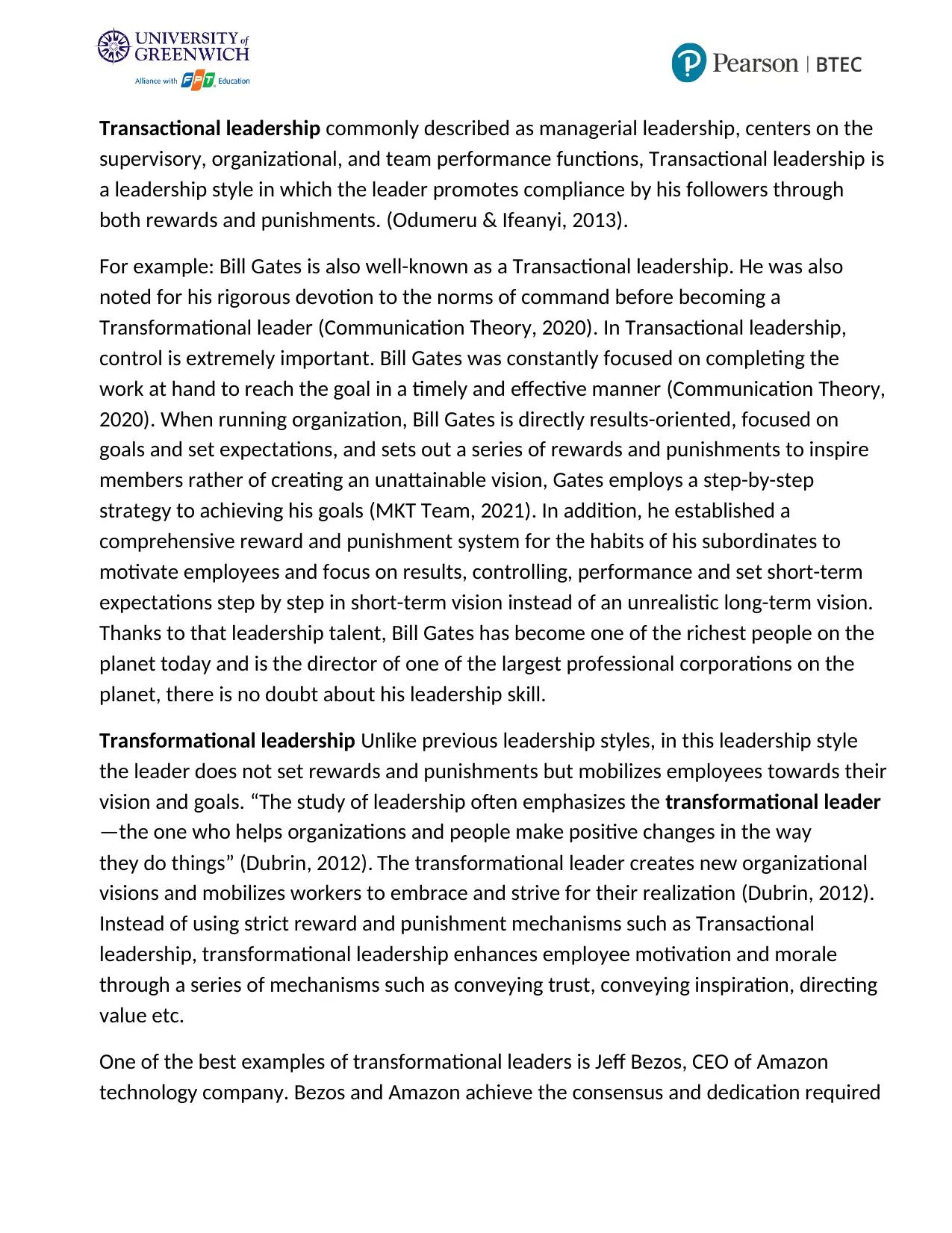
Transactional leadership commonly described as managerial leadership, centers on the
supervisory, organizational, and team performance functions, Transactional leadership is
a leadership style in which the leader promotes compliance by his followers through
both rewards and punishments. (Odumeru & Ifeanyi, 2013).
For example: Bill Gates is also well-known as a Transactional leadership. He was also
noted for his rigorous devotion to the norms of command before becoming a
Transformational leader (Communication Theory, 2020). In Transactional leadership,
control is extremely important. Bill Gates was constantly focused on completing the
work at hand to reach the goal in a timely and effective manner (Communication Theory,
2020). When running organization, Bill Gates is directly results-oriented, focused on
goals and set expectations, and sets out a series of rewards and punishments to inspire
members rather of creating an unattainable vision, Gates employs a step-by-step
strategy to achieving his goals (MKT Team, 2021). In addition, he established a
comprehensive reward and punishment system for the habits of his subordinates to
motivate employees and focus on results, controlling, performance and set short-term
expectations step by step in short-term vision instead of an unrealistic long-term vision.
Thanks to that leadership talent, Bill Gates has become one of the richest people on the
planet today and is the director of one of the largest professional corporations on the
planet, there is no doubt about his leadership skill.
Transformational leadership Unlike previous leadership styles, in this leadership style
the leader does not set rewards and punishments but mobilizes employees towards their
vision and goals. “The study of leadership often emphasizes the transformational leader
—the one who helps organizations and people make positive changes in the way
they do things” (Dubrin, 2012). The transformational leader creates new organizational
visions and mobilizes workers to embrace and strive for their realization (Dubrin, 2012).
Instead of using strict reward and punishment mechanisms such as Transactional
leadership, transformational leadership enhances employee motivation and morale
through a series of mechanisms such as conveying trust, conveying inspiration, directing
value etc.
One of the best examples of transformational leaders is Jeff Bezos, CEO of Amazon
technology company. Bezos and Amazon achieve the consensus and dedication required
supervisory, organizational, and team performance functions, Transactional leadership is
a leadership style in which the leader promotes compliance by his followers through
both rewards and punishments. (Odumeru & Ifeanyi, 2013).
For example: Bill Gates is also well-known as a Transactional leadership. He was also
noted for his rigorous devotion to the norms of command before becoming a
Transformational leader (Communication Theory, 2020). In Transactional leadership,
control is extremely important. Bill Gates was constantly focused on completing the
work at hand to reach the goal in a timely and effective manner (Communication Theory,
2020). When running organization, Bill Gates is directly results-oriented, focused on
goals and set expectations, and sets out a series of rewards and punishments to inspire
members rather of creating an unattainable vision, Gates employs a step-by-step
strategy to achieving his goals (MKT Team, 2021). In addition, he established a
comprehensive reward and punishment system for the habits of his subordinates to
motivate employees and focus on results, controlling, performance and set short-term
expectations step by step in short-term vision instead of an unrealistic long-term vision.
Thanks to that leadership talent, Bill Gates has become one of the richest people on the
planet today and is the director of one of the largest professional corporations on the
planet, there is no doubt about his leadership skill.
Transformational leadership Unlike previous leadership styles, in this leadership style
the leader does not set rewards and punishments but mobilizes employees towards their
vision and goals. “The study of leadership often emphasizes the transformational leader
—the one who helps organizations and people make positive changes in the way
they do things” (Dubrin, 2012). The transformational leader creates new organizational
visions and mobilizes workers to embrace and strive for their realization (Dubrin, 2012).
Instead of using strict reward and punishment mechanisms such as Transactional
leadership, transformational leadership enhances employee motivation and morale
through a series of mechanisms such as conveying trust, conveying inspiration, directing
value etc.
One of the best examples of transformational leaders is Jeff Bezos, CEO of Amazon
technology company. Bezos and Amazon achieve the consensus and dedication required
Paraphrase This Document
Need a fresh take? Get an instant paraphrase of this document with our AI Paraphraser
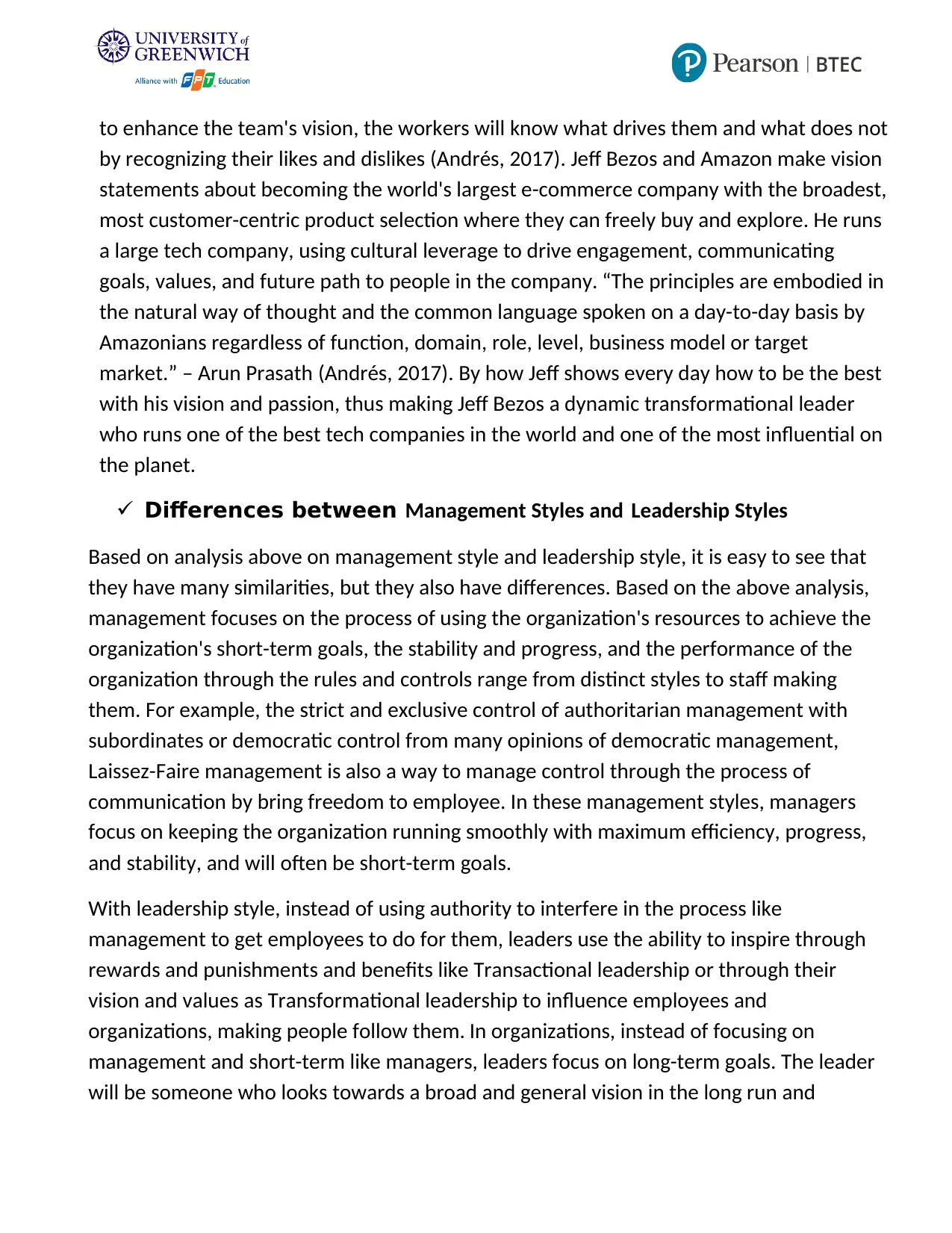
to enhance the team's vision, the workers will know what drives them and what does not
by recognizing their likes and dislikes (Andrés, 2017). Jeff Bezos and Amazon make vision
statements about becoming the world's largest e-commerce company with the broadest,
most customer-centric product selection where they can freely buy and explore. He runs
a large tech company, using cultural leverage to drive engagement, communicating
goals, values, and future path to people in the company. “The principles are embodied in
the natural way of thought and the common language spoken on a day-to-day basis by
Amazonians regardless of function, domain, role, level, business model or target
market.” – Arun Prasath (Andrés, 2017). By how Jeff shows every day how to be the best
with his vision and passion, thus making Jeff Bezos a dynamic transformational leader
who runs one of the best tech companies in the world and one of the most influential on
the planet.
Differences between Management Styles and Leadership Styles
Based on analysis above on management style and leadership style, it is easy to see that
they have many similarities, but they also have differences. Based on the above analysis,
management focuses on the process of using the organization's resources to achieve the
organization's short-term goals, the stability and progress, and the performance of the
organization through the rules and controls range from distinct styles to staff making
them. For example, the strict and exclusive control of authoritarian management with
subordinates or democratic control from many opinions of democratic management,
Laissez-Faire management is also a way to manage control through the process of
communication by bring freedom to employee. In these management styles, managers
focus on keeping the organization running smoothly with maximum efficiency, progress,
and stability, and will often be short-term goals.
With leadership style, instead of using authority to interfere in the process like
management to get employees to do for them, leaders use the ability to inspire through
rewards and punishments and benefits like Transactional leadership or through their
vision and values as Transformational leadership to influence employees and
organizations, making people follow them. In organizations, instead of focusing on
management and short-term like managers, leaders focus on long-term goals. The leader
will be someone who looks towards a broad and general vision in the long run and
by recognizing their likes and dislikes (Andrés, 2017). Jeff Bezos and Amazon make vision
statements about becoming the world's largest e-commerce company with the broadest,
most customer-centric product selection where they can freely buy and explore. He runs
a large tech company, using cultural leverage to drive engagement, communicating
goals, values, and future path to people in the company. “The principles are embodied in
the natural way of thought and the common language spoken on a day-to-day basis by
Amazonians regardless of function, domain, role, level, business model or target
market.” – Arun Prasath (Andrés, 2017). By how Jeff shows every day how to be the best
with his vision and passion, thus making Jeff Bezos a dynamic transformational leader
who runs one of the best tech companies in the world and one of the most influential on
the planet.
Differences between Management Styles and Leadership Styles
Based on analysis above on management style and leadership style, it is easy to see that
they have many similarities, but they also have differences. Based on the above analysis,
management focuses on the process of using the organization's resources to achieve the
organization's short-term goals, the stability and progress, and the performance of the
organization through the rules and controls range from distinct styles to staff making
them. For example, the strict and exclusive control of authoritarian management with
subordinates or democratic control from many opinions of democratic management,
Laissez-Faire management is also a way to manage control through the process of
communication by bring freedom to employee. In these management styles, managers
focus on keeping the organization running smoothly with maximum efficiency, progress,
and stability, and will often be short-term goals.
With leadership style, instead of using authority to interfere in the process like
management to get employees to do for them, leaders use the ability to inspire through
rewards and punishments and benefits like Transactional leadership or through their
vision and values as Transformational leadership to influence employees and
organizations, making people follow them. In organizations, instead of focusing on
management and short-term like managers, leaders focus on long-term goals. The leader
will be someone who looks towards a broad and general vision in the long run and
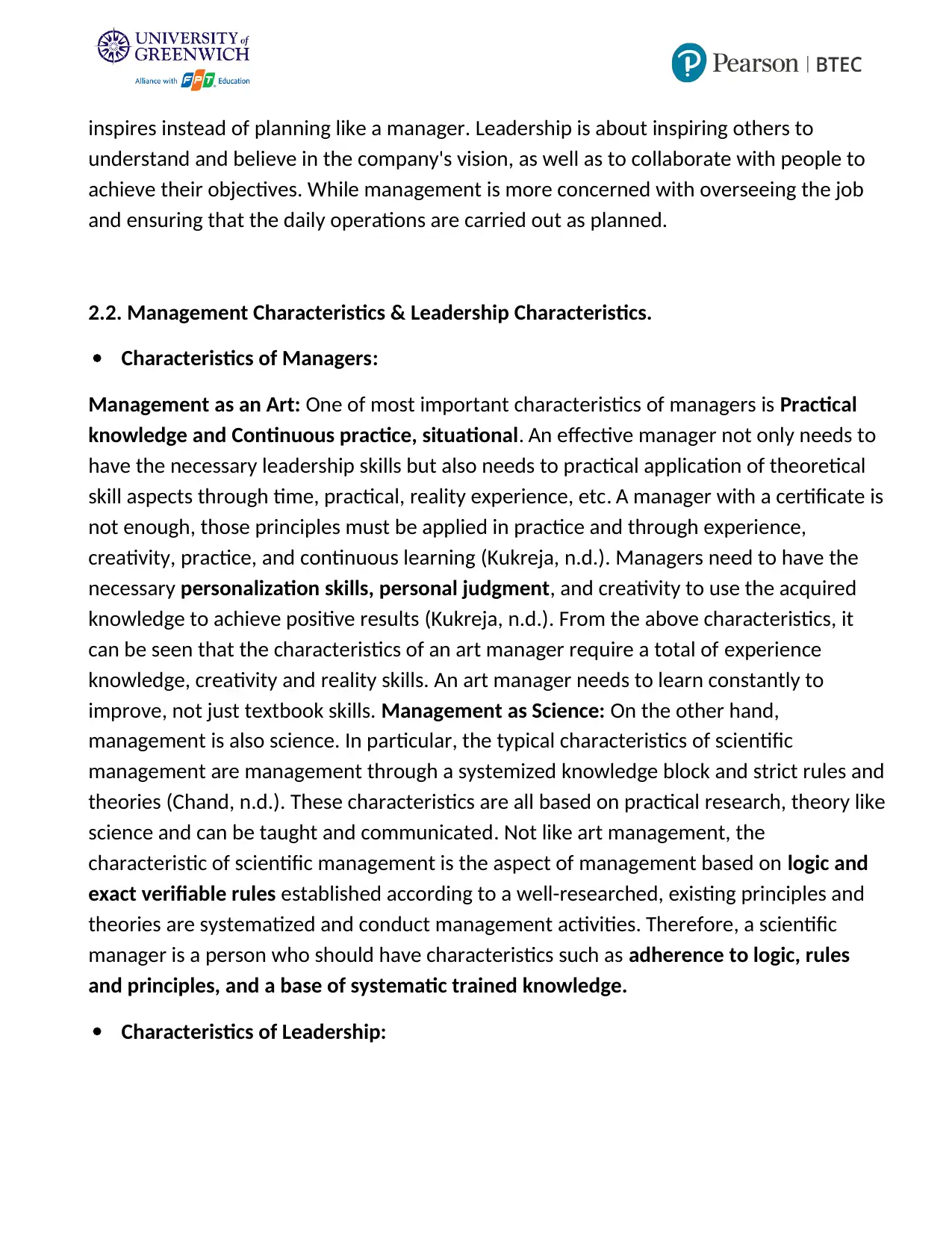
inspires instead of planning like a manager. Leadership is about inspiring others to
understand and believe in the company's vision, as well as to collaborate with people to
achieve their objectives. While management is more concerned with overseeing the job
and ensuring that the daily operations are carried out as planned.
2.2. Management Characteristics & Leadership Characteristics.
Characteristics of Managers:
Management as an Art: One of most important characteristics of managers is Practical
knowledge and Continuous practice, situational. An effective manager not only needs to
have the necessary leadership skills but also needs to practical application of theoretical
skill aspects through time, practical, reality experience, etc. A manager with a certificate is
not enough, those principles must be applied in practice and through experience,
creativity, practice, and continuous learning (Kukreja, n.d.). Managers need to have the
necessary personalization skills, personal judgment, and creativity to use the acquired
knowledge to achieve positive results (Kukreja, n.d.). From the above characteristics, it
can be seen that the characteristics of an art manager require a total of experience
knowledge, creativity and reality skills. An art manager needs to learn constantly to
improve, not just textbook skills. Management as Science: On the other hand,
management is also science. In particular, the typical characteristics of scientific
management are management through a systemized knowledge block and strict rules and
theories (Chand, n.d.). These characteristics are all based on practical research, theory like
science and can be taught and communicated. Not like art management, the
characteristic of scientific management is the aspect of management based on logic and
exact verifiable rules established according to a well-researched, existing principles and
theories are systematized and conduct management activities. Therefore, a scientific
manager is a person who should have characteristics such as adherence to logic, rules
and principles, and a base of systematic trained knowledge.
Characteristics of Leadership:
understand and believe in the company's vision, as well as to collaborate with people to
achieve their objectives. While management is more concerned with overseeing the job
and ensuring that the daily operations are carried out as planned.
2.2. Management Characteristics & Leadership Characteristics.
Characteristics of Managers:
Management as an Art: One of most important characteristics of managers is Practical
knowledge and Continuous practice, situational. An effective manager not only needs to
have the necessary leadership skills but also needs to practical application of theoretical
skill aspects through time, practical, reality experience, etc. A manager with a certificate is
not enough, those principles must be applied in practice and through experience,
creativity, practice, and continuous learning (Kukreja, n.d.). Managers need to have the
necessary personalization skills, personal judgment, and creativity to use the acquired
knowledge to achieve positive results (Kukreja, n.d.). From the above characteristics, it
can be seen that the characteristics of an art manager require a total of experience
knowledge, creativity and reality skills. An art manager needs to learn constantly to
improve, not just textbook skills. Management as Science: On the other hand,
management is also science. In particular, the typical characteristics of scientific
management are management through a systemized knowledge block and strict rules and
theories (Chand, n.d.). These characteristics are all based on practical research, theory like
science and can be taught and communicated. Not like art management, the
characteristic of scientific management is the aspect of management based on logic and
exact verifiable rules established according to a well-researched, existing principles and
theories are systematized and conduct management activities. Therefore, a scientific
manager is a person who should have characteristics such as adherence to logic, rules
and principles, and a base of systematic trained knowledge.
Characteristics of Leadership:
⊘ This is a preview!⊘
Do you want full access?
Subscribe today to unlock all pages.

Trusted by 1+ million students worldwide
1 out of 19
Related Documents
Your All-in-One AI-Powered Toolkit for Academic Success.
+13062052269
info@desklib.com
Available 24*7 on WhatsApp / Email
![[object Object]](/_next/static/media/star-bottom.7253800d.svg)
Unlock your academic potential
Copyright © 2020–2025 A2Z Services. All Rights Reserved. Developed and managed by ZUCOL.





